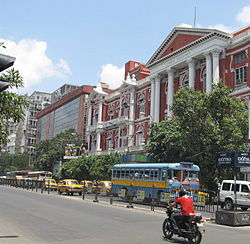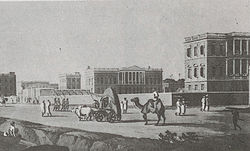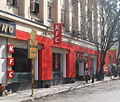- Chowringhee
-
Chowringhee — Neighbourhood in Kolkata (Calcutta) — Chowringhee in 2007 Coordinates: 23°48′N 88°15′E / 23.8°N 88.25°ECoordinates: 23°48′N 88°15′E / 23.8°N 88.25°E Country  India
IndiaState West Bengal City Kolkata Ward # 46,52,61,62,63 Metro Stations Esplanade, Park Street, Maidan Parliamentary constituency Kolkata Uttar Assembly constituency Chowranghee Government - MLA Subrata Bakshi Elevation 36 ft (11 m) Population (2001) - Total 159,917 Time zone IST (UTC+5:30) PIN 700087, 700016 Area code(s) +91 33 Chowringhee (also spelt Chourangi) (Bengali: চৌরঙ্গী) is a neighbourhood in central Kolkata, earlier known as Calcutta, in the Indian state of West Bengal. Jawaharlal Nehru Road (earlier known as Chowringhee Road) runs on its western side. A neighbourhood steeped in history, it is a business district,[1] as well as a shopper’s destination and entertainment-hotel centre
Contents
Etymology
The name ‘Chowringhee’ has defied etymologists. There is, however, the legend of a yogi, Chourangi Giri, who discovered an image of the goddess Kali’s face and built the first and founded the original Kalighat temple.[2]
History
The village
In the seventeenth century or prior to it, the area now occupied by the Maidan and Esplanade was a tiger-infested jungle. At the eastern end of it was an old road, which had once been built by the Sabarna Roy Choudhury family from Barisha to Halisahar. Beyond it there were “pools, swamps and rice-fields, dotted here and there with the straggling huts of fishermen, falconers, wood-cutters, weavers and cultivators. In that region were three small hamlets – Chowringhee, Birjee and Colimba.[3]
In 1717, Chowringhee was a hamlet of isolated hovels, surrounded by water-logged paddy-fields and bamboo-groves separated from Gobindapur by the jungle.[3] Tradition has it that Warren Hastings, hunted with elephants in the jungle.[4] Birjee occupied the south-eastern end of later day Maidan, Victoria Memorial and Rabindra Sadan area. Colimba took its name from the Bengali word for musk melon.[2]
Urbanisation
The strengthening of British power, subsequent to their victory in the Battle of Plassey was followed by the construction of the new Fort William, in 1758. The European inhabitants of Kalikata gradually forsook the narrow limits of the old palisades and moved to around the Maidan.[5] In the mid eighteenth century Englishmen began to build magnificent houses on the Chowringhee that earned Kolkata the title of ‘City of Palaces’.[6]
The first road in Kolkata to be macadamised was Chitpur Road in 1839. In the evening of 6 July 1857 Chowringhee was lit up with gas lights provided by the Oriental Gas Company. Building of pavements started in 1858, first in Chowringhee and then elsewhere. The pavements were built to facilitate the erection of gas lamps. The traders objected as their customers were forced to park their carriages some distance from the shops.[6]
The neighbourhood
The ‘road to Chowringhee’ ran from Lower Circular Road (renamed Acharya Jagadish Chandra Bose Road) in the south to Dharmatala in the north. According to old maps, Chowringhee is a locality, not a road. In Colonel Mark Wood’s map of 1784 while the road is marked ‘Road to Chowringhee’, the name ‘Chowringhee’ is given to the locality immediately south of Park Street. However, in Upjohn’s map of 1794, this district is marked Dhee Birjee and boundaries of Chowringhee appear as Circular Road on the east, Park Street on the south, Colinga on the north and a portion of ‘Road to Chowringhee’ on the west.[4]
Fame and fortune have attended Chowringhee Road for nearly three centuries. One of Kolkata's principal arteries, throughout the length of its history it has carried an aura of prestige and importance. Fashionableness and colour have always been its handmaidens. To countless Indians, and for most people familiar with India, the singularly unique name Chowringhee immediately identifies with Kolkata.
It represents the nearest equation in India to what Piccadilly is to London, Fifth Avenue to New York and the Champs Elysees to Paris. Nostalgic Londoners like to regard their Circus as the centre of the universe. Kolkatans are more reserved in their acclaim , although the fervour they display for their city is perhaps unmatched.[7]
David William Martin
in The changing face of KolkataTravelling along the ‘Road to Chowringhee’ from south to north, the first crossing was with Theatre Road (renamed Shakespeare Sarani). At that corner was the Theatre of Calcutta from 1813 to 1839. It was destroyed in a fire. The next turning is that of Harrington Street (renamed Ho Chi Minh Sarani) named after John Herbert Harrington, a judge of the Sadar Adalat. The next crossing Middleton Street was named after Dr. Thomas Fanshaw Middleton, the first Bishop of Kolkata (1814–1822). Further down the road was Bengal Club (it is still there). The building was once the residence of Thomas Babington Macaulay. Behind Bengal Club ran Russel Street (renamed Anandi Lal Poddar Sarani), named after Sir Henry Russel, Chief Justice of the Supreme Court from 1806-1813.[4]
At the next crossing with Park Street (renamed Mother Teresa Sarani), is the Asiatic Society. Park Street is not shown in any map earlier than 1760. In Upjohn’s map of 1794 it is called ‘Burial-ground Road’, which means it led to the burial ground on Circular Road. The site of Sir Elijah Impey’s residence on Middleton Row now houses Loreto House and Loreto College. St. Xavier’s College, the great institution of Jesuit Fathers, was once Sans Souci Theatre. It was formally opened in 1841 and was sold in 1844 to Arch Bishop Carew.[4]
Camac Street (renamed Abanindranath Tagore Sarani) running from Park Street to Circular Road was named after William Camac, a senior merchant in the days of Cornwallis and Wellesley. Wood Street was named after Henry Wood. Free School Street (renamed Mirza Ghalib Street), named after a Free School established there in 1786, was a bamboo jungle in 1780.[4]
The next crossing is that with Kyd Street, named after Lt. Col. Robert Kyd, Military Secretary to the Government of Bengal, who lived on that road. The road was earlier named Chowringhee Tank Street, after the tank that is still there opposite to the crossing with Park Street.[8]
The first of the many English play houses, the Calcutta Theatre, had been built as early as 1775 in what is now Lyons Range… A series of English theatres opened and closed over the next eighty years. Among them was the famous Chowringhee Theatre (1813-1839) which gave its name to Theatre Road (now Shakespeare Sarani), and the Sans Souci set up in 1839 and moved in 1841 to the present site of St. Xavier’s College on Park Street. These companies enjoyed a steady inflow of experienced even renowned actors and actresses, sometimes from the London stage:Emma Bristow, Esther Leach, James Vining, Mrs. Deacle, Miss Cowley. At first the audience was exclusively European – even the ushers and door keepers at the Calcutta Theatre were Englishmen – but Indians gained entry from the early nineteenth century and the English theatre became a haunt, and sometimes a source of serious interest, of the emerging English-educated Bengalis. A minor landmark was set up when ‘Prince’ Dwarkanath Thakur became one of the founders of Chowringhee Theatre; a more memorable one in August 1848 when a ‘Native Gentleman’, Baishnabcharan Adhya, played Othello at the Sans Souci. Yet the Calcutta Star’s notice of ‘a real unpainted nigger Othello’ suggests ambiguous and even offensive nature of such accommodation.[9]
Kironmay RahaSudder Street, north of the Indian Museum once housed the Sudder Court. The area beyond it is Colinga (from Colimba) and tank in the Maidan was called Colinga Tank. Lindsay Street leading to the municipal market, was named Robert Lindsay, who had a colourful career with East India Company and once owned a house on the street. The Opera House, a wooden building, was once located on Lindsay Street.[8]Grand Hotel is an important landmark on Jawaharlal Nehru Road.
New names
Indian independence saw a rush to rename streets. The process has slowed down as few streets are left to be renamed. Chowringhee Road was renamed after Jawaharlal Nehru, the first Prime Minister of India. Park Street was renamed after Mother Teresa. Theatre Road was renamed after William Shakespeare. There was no street named after the poet during the long years of British rule in India. Harrington Street was renamed after the leader of the Vietnam independence movement, Ho Chi Minh. Camac Street has been renamed after the great artist Abanindranath Tagore. Russel Street was renamed after industrialist Anandi Lal Poddar. Free School Street was renamed after the Urdu/ Persian poet Mirza Ghalib. Kyd Street was renamed Dr. Md. Ishaque Road. Lindsay Street was renamed after Nellie Sengupta.
Geography
The Chowringhee neighbourhood is located in central Kolkata. It has Janbazar on the north, Taltala and certain areas under Park Street Police Station on the east, Bhowanipore on the south and the Maidan on the west. The neighbourhood is spread over areas under New Market,[10] Park Street,[11] and Shakespeare Sarani police stations.[12]
Demographics
Chowringhee is spread over parts of ward nos. 46, 52, 61, 62, and 63 of Kolkata Municipal Corporation. These wards taken together had a total population of 159, 917 in the 2001 census, of which 101,189 were males and 58,828 were females.[13] A major portion of this population lived in Chowringhee neighbourhood.
Creative inspiration
Life in the neighbourhood has inspired creative efforts.
The Bengali novelist Sankar wrote Chowringhee in 1962 (three years before Arthur Hailey’s Hotel). It became an instant hit. Set in Kolkata of 1950s, it is the saga of the intimate lives of the staff and the guests at the Shahjahan, one of the largest city hotels located in the neighbourhood, which is the title of the novel. Some of its larger-than-life characters, as for example the enigmatic manager Marco Polo, the debonair receptionist Sata Bose, and the tragic hostess Karabi Guha, attained cult status. It has been translated into English by Arunava Sinha and is available as a Penguin paper-back. It has also been translated into several Indian languages.[14] Film director, Pinaki Bhusan Mikherjee made it into a successful film in 1968. It was also made into a play.[15]
In 1981, Aparna Sen wrote and directed a film, 36 Chowringhee Lane, about an aged Anglo-Indian school teacher who lives a lonely life in a single room flat in the neighbourhood.[16]
Images
-
KFC outlet on Middleton Row
References
- ^ "Tax lawyer is CPM candidate for Chowringhee seat". The Hindu Business Line, 18 February 2006. http://www.thehindubusinessline.com/2006/02/18/stories/2006021803341900.htm. Retrieved 2008-01-16.
- ^ a b Nair, P. Thankappan in The Growth and Development of Old Calcutta, in Calcutta, the Living City, Vol. I, edited by Sukanta Chaudhuri, pp. 14-15, Oxford University Press, ISBN 978-0-19-563696-3.
- ^ a b Cotton, H.E.A., Calcutta Old and New, 1909/1980, p. 19, General Printers and Publishers Pvt. Ltd.
- ^ a b c d e Cotton, H.E.A., pp. 230-236.
- ^ Cotton, H.E.A., p. 72.
- ^ a b Nair, P.Thankappan, Civic and Public Services in Old Calcutta, in Calcutta, the Living City, Vol. I, p. 224
- ^ "Now and Then". Choweinghee. kolkatainformation. http://www.astrainfotech.org/kolkatainformation/calhert/chowringhee.htm. Retrieved 2008-01-16.
- ^ a b Cotton, H.E.A., pp. 244-247
- ^ Raha, Kironmoy, Calcutta Theatre 1835-1944, in Calcutta, the Living City, Vol. I, pp. 186-187
- ^ "New Market Police Station". Kolkata Police. Archived from the original on 2007-09-27. http://web.archive.org/web/20070927201341/http://www.kolkatapolice.org/section.asp?PSID=13&Typ=PS. Retrieved 2008-01-16.
- ^ "Park Street Police Station". Kolkata Police. http://www.kolkatapolice.org/section.asp?PSID=14&Typ=PS. Retrieved 2008-01-16.[dead link]
- ^ "Shakespeare Sarani Police Station". Kolkata Police. http://www.kolkatapolice.org/section.asp?PSID=15&Typ=PS. Retrieved 2008-01-16.[dead link]
- ^ "Provisional Population Totals, Table 4". Population, Decadal Growth Rate, Density and General Sex Ratio by Residence and Sex, West Bengal/ District/ Sub District, 1991 and 2001. Census Commission of India. Archived from the original on 2007-09-27. http://web.archive.org/web/20070927041607/http://www.wbcensus.gov.in/DataTables/02/Table4_17.htm. Retrieved 2007-10-10.
- ^ "Details of Chwringhee". Indiatimes Shopping. http://shopping.indiatimes.com/ism/faces/tiles/product.jsp?productID=1436445&catalogueID=20375432&toi_chowri_0805. Retrieved 2008-01-16.
- ^ "Chwringhee (1968)". imdb.com. http://www.imdb.com/title/tt0244460/. Retrieved 2008-01-16.
- ^ "36 Chowringhee Lane (1981)". imdb.com. http://www.imdb.com/title/tt0081968/. Retrieved 2008-01-16.
Categories:- Neighbourhoods in Kolkata
- Shopping districts and streets in India
Wikimedia Foundation. 2010.








